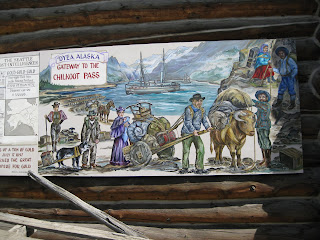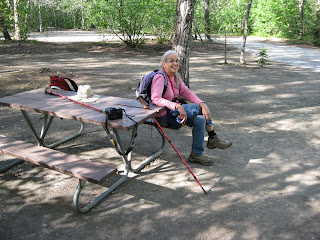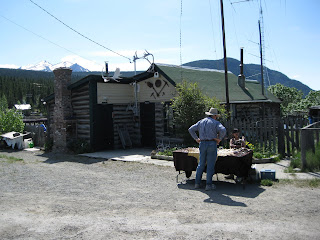We arrived in Skagway on the same day that three cruise ships docked, so we decided to skip this "tourist town" and catch the earliest Alaska Marine Highway ferry over to Haines. Haines is only 15 miles from Skagway by water, but it is 359 miles by road! Gas was costing about $3.50 per gallon, so we decided that the ferry fare of $151.00 for both of us and the RV was a good deal.
Our Lazy Daze group had planned to stay at The Oceanview RV Park so we pulled in there, and when we found out they were full we bartered for spot where we could dry camp. We ended up perched on the back of the parking lot, on the very edge of Portage Cove. It felt a little precarious, but the view was to die for so we stayed.
The days we were in Haines were overcast and rainy but we stayed because we had good internet connections for the first time in nearly two weeks. We took the opportunity to hunker down in the RV and catch up on our e-mails and our Blogs.
We went for walks into town for exercise and to get the feel of this laid back community. The first day we were amazed to see people wearing tank tops in the 52 degree weather. I guess if it is June, you figure it must be summer. I was also impressed by the bright flowers planted throughout the town and the vibrant hanging baskets.
One day we stopped by the Chilkat Bakery for some hot coffee and a treat, and discovered that the business was owned by a Thai woman who came here from Portland, Oregon. Small world!
The Milepost explained that the original Indian name for Haines was Die-Shu, meaning "end of the trail". The name refers to where Chilkat and Chilkoot Indians met and traded with Russian and American ships here, at the end of the Kenai Peninsula. Fishing and gold mining were the initial industries of the early settlers, and now Haines is the gateway to the Alaska Highway for inside passage travellers, and caters to tourists passing through.
One of the big attractions is The Alaska Chilkat Bald Eagle Preserve, just north of Homer. From mid-October through December, 3,500 bald eagles gather there for the late run of salmon. In 1982 a 48,000 acre preserve was established to protect this habitat. Unfortunately, we were there at the wrong time of year to see that. However, we pulled out at one of the many wayside areas to look at the Chilkat River and check with our binoculars just in case there was an "early bird" around.
In some places, like Whitehorse and Dyea, I had wanted to get right in the middle of them and feel them. Looking back I realize that I just floated through Haines without really being touched by it. Maybe the weather had something to do with it, or maybe I was just ready for some down-time.



















































